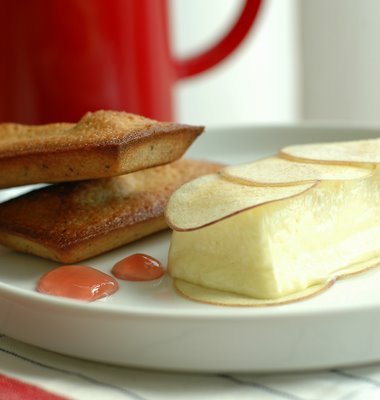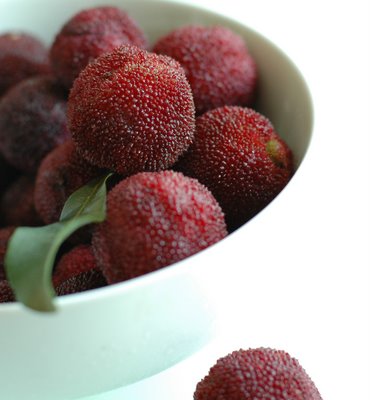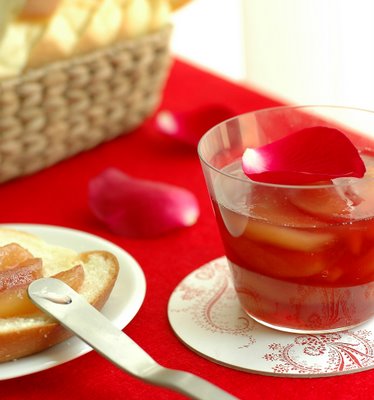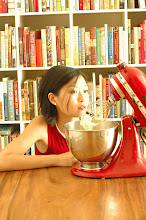How to Read a Peach
 Apart from "Eat me. Now."? Sure, if you're lush and ripe.
Apart from "Eat me. Now."? Sure, if you're lush and ripe.But faced with a mixed lot of varying ripeness, what's a girl to do but tamper with nature?
It's been close to a year since such a bountiful windfall of Wuxi and Okayama Shimizu white peaches landed in my lap (courtesy once again of paternal generousity). Which led me to realize it's been more than a year since I first discovered the joys of of blogging. But that's not news - I've never been very good at remembering birthdays, anniversaries and their ilk.
Back to the peaches. The verging on over-ripe are ideal for ice-creams, sorbets, parfaits and mousses. In other words, recipes which call for a puree of peaches; the soft texture of the fruit doesn't matter in this instance, while their full-flavoured juiciness ensures an end result that's sufficiently intense (important, as the flavour will be muted by the addition of cream and eggs).
The young and firm-of-flesh, just this shade of under-ripe? The texture, a flaw when raw, becomes an asset when the peach is poached or roasted - it's sufficiently resilient to hold its shape whilst being cooked without becoming mushy, and is vastly enhanced flavour-wise by the syrupy bath in which it sits.
As for ripe peaches, they are ideal for jam-making. It's a prevalent myth (outrageously, one that's perpetuated by the odd cookbook here and there) that you can bung any old fruit from all walks of ripeness into the preserving pan and expect decent jam to emerge. Just as the stockpot shouldn't be treated as a garbage bin for tired old carcasses and "off" scraps - not if you're aiming for a good stock, that is - the preserving pan shouldn't be used as a catchall for anything less than perfectly ripe specimens, unblemished and with no bruising whatsoever. Ripe fruit posesses the ideal balance of acidity and pectin, the latter being what sets the jam.
Below, how I sorted the three.
 White Peach Parfait with Hazelnut Financiers
White Peach Parfait with Hazelnut Financiers
The sensational yet easy recipe for the parfait can be found in Gordon Ramsay's Just Desserts. It's made by combining peach puree with pâte à bombe, meringue, and whipped cream, and garnished with wafer-thin slices of oven-dried peach (incidentally, another good use for firm, under-ripe fruit). That's a lot of whipping. But a heavy duty stand mixer takes the elbow grease out of the equation. In fact, I don't think I would bother with pâte à bombe otherwise, made by vigorously beating a just-boiled sugar solution cooked to hard ball stage into whisked egg yolks to create an endlessly useful base for many mousse and parfait recipes.
That's a lot of whipping. But a heavy duty stand mixer takes the elbow grease out of the equation. In fact, I don't think I would bother with pâte à bombe otherwise, made by vigorously beating a just-boiled sugar solution cooked to hard ball stage into whisked egg yolks to create an endlessly useful base for many mousse and parfait recipes. The droplets of gelée that sit alongside were made from a surprise my Dad had tucked into the box with the white peaches - a punnet of yamamomo, the deliciously tart fruit (also known as Japanese bayberry) with an all-too-fleeting season.
The droplets of gelée that sit alongside were made from a surprise my Dad had tucked into the box with the white peaches - a punnet of yamamomo, the deliciously tart fruit (also known as Japanese bayberry) with an all-too-fleeting season.
Baking the batter in anything other than the traditional rectangular mold with sharply angled sides (measuring 4 by 2 by 5/8 inches), say oval barquette molds or mini-muffin pans, would taste as sweet. Just don't call them financiers - these tea cakes were named not just for their rich ingredients, but for the moneyed clientele they were originally created for by a Parisian pâtisserie near the Bourse, with a form inspired by - what else - ingots of gold. Once baked, they will keep for up to a day. But like madeleines, they really are at their best moments after their exit from the oven - fortunately, as with madeleine batter, financier batter should be given an overnight rest, and in fact keeps well for several days, making it easy to bake up a batch shortly prior to serving. Not quite so freshly baked, that's when they're just right - again like madeleines - for a spot of Proustian tea-dipping.
 Olive Oil and Sauternes Cake with Slow Roasted Peaches in Orange Caramel
Olive Oil and Sauternes Cake with Slow Roasted Peaches in Orange Caramel
Another peachy winner from Gordon Ramsay's Just Desserts - the heat of the oven helps intensify the flavour of the peaches.
 The orange caramel sauce used to baste the peaches is infused with vanilla, all of which really gives the fruit a boost.
The orange caramel sauce used to baste the peaches is infused with vanilla, all of which really gives the fruit a boost.
Olive oil cake makes more than an occasional appearance in many a modern cookbook, but the grand dame of them all is probably the Olive Oil & Sauternes classic developed by Linda P. Guenzel from Alice Waters' Chez Panisse Menu Cookbook, which re-appears later in Lindsey Remolif Shere's Chez Panisse Desserts in a slightly tweaked form for a lighter cake. It's a heavenly idea that's inspired many others; I first came across it in a roundabout fashion - not in either of the Chez Panisse titles but in Alastair Little's Keep It Simple.
As an elegant dinner party dessert, it is sublime paired with fresh or poached peaches and a Sauternes-laced sabayon, accompanied by a glass of more of that divine golden nectar. Nectarines and apricots also work. When peaches aren't in season, or simply to ring the changes, try a compote of dried fruit poached in an Earl Grey tea syrup or spiced red wine syrup. As an afternoon tea treat, have it alone or topped with a dollop of softly whipped cream, a tumble of raspberries and a trickle of raspberry coulis.
No one's suggesting you bust out a vintage d'Yquem to flavour the cake. A less prohibitively priced bottling will do, and most other dessert wines also do a fine job - from other noble rot numbers (like an Austrian or German Trockenbeerenauslese, Alsatian selection de grains nobles, or Hungarian Tokaji aszú), to eiswein/icewine, late harvest wines, and passito-style. Even more accessibly, a fortified sweet muscat from Beaumes-de-Venise or Australia. The olive oil, however, must be the very best you can afford - extra virgin, bursting with fruit, and likely to be as dear as a mid-priced Sauternes (try to avoid an oil with too peppery a bite) - seeing as it completely takes the place of butter in the cake batter.
However, for all its apparent simplicity, getting the texture right is a tad tricky - a deft but assured touch when folding is necessary so the cake doesn't become heavy (although if it is, it will still be delicious and full of flavour). So I really like the virtually fool-proof recipe for Olive Oil Cake in Suzanne Goin's Sunday Suppers at Lucques - she's significantly bumped up the olive oil quotient so the flavour is pretty pronounced, while the inclusion of semolina gives the cake a lovely texture - very moist and appealingly close-crumbed, with excellent keeping properties. This time round, I used Sauternes instead of the brandy called for in Ms. Goin's recipe, and also added some orange zest for a subtly citrusy dimension. (For an all-out citrus take, I'm keen to check out the Olive Oil & Orange Juice Cake with Pinenuts in Tessa Kiros' Apples for Jam.)
 White Peach with Rose de Chine Tea Preserves
White Peach with Rose de Chine Tea Preserves
Very feminine preserves, based on a recipe from Christine Ferber's Mes Confitures. Instead of using Rose de Chine (hibiscus) tea, I went for a hibiscus and rosehip blend - either way, loose leaf please. The recipe is not in the least complicated (there's no need to make an apple stock jelly beforehand). The key, as always, lies in Ms. Ferber's technique; the fruit is macerated and cooked several times so that the sugar is absorbed gradually by the fruit - this way, the succulent texture of the fruit is not compromised. Fresh lemon juice is used for macerating not only to prevent oxidation and preserve colour, but its acidity enhances the fruit flavour while awakening the gelling power of the natural pectin present. If you have ripe white peaches to spare, there are few nicer ways to extend your enjoyment of them than making jam - this one's deliciously different.
1.3 kg white peaches
800gm caster sugar
Juice of 1 small lemon
25g hibiscus tea, or a hibiscus and rose hip blend
200ml water
Blanch the white peaches for 1 minute in a pot of boiling water. Refresh them in ice water. Peel them (the skins should slip right off if the peaches were nicely ripe to begin with). Remove the pits and slice the flesh.
In a preserving pan, mix the peach slices, sugar and lemon juice. Bring to a gentle simmer, then pour into a ceramic or glass bowl. Cover the preparation with a circle of parchment paper to help keep the fruit submerged. Clingwrap the bowl and refrigerate overnight.
The next day, pour the preparation into a sieve placed over a preserving pan. Set the peaches aside. Bring the collected syrup to a boil. Skim rigorously of any scum, foam and flotsam as you cook on high heat. Clip on a candy thermometer - the syrup should be sufficiently concentrated at 221°F/105°C.
Meanwhile, bring the water to a boil. Pour onto the tea. Steep for 3 minutes. Strain and discard the spent tea.
Add the peach slices and tea to the cooking syrup. Return this to a boil and cook on high heat for about 5 minutes, stirring gently. Keep on skimming diligently. Check the set - either use the candy thermometer (the temperature has to climb back to 221°F/105°C), or put a few drops of jam on a cold plate to monitor the consistency. This is intended to be a soft-set jam with a consistency much like thick honey. Ladle the jam into sterilized jars immediately and seal.



25 Comments:
Well, I guess that answers my question :-) You've certainly been busy. Now I wish I had done something more creative with those peaches other than devouring them whole. Um, does this mean I get some jam? :p
Everything looks amazing. You rock!
What an interesting post ! Pictures look gorgeous.
Wow! What better ways to showcase one of nature's most perfect creations? I love all your ideas here (not to mention you've pointed me to some overlooked recipes in books already on my shelf), and you've described and photographed them in such exquisite style. Good peaches haven't yet reached the markets here, but when they do you can bet I won't be cooking much else. Oh, and of course a very, very happy blogging anniversary! :)
Hi Jocelyn, i was acually looking for a sophisticated dessert using apricots. And as you mentioned white peaches could easly be replaced by apricots, i think i'm gonna have a go.
This olive oil and sauterne cake looks so feathery!
Wow. Wow. Wow. My head is going to explode, this all looks so good. The parfait is just amazing.
J,
As soon as I happened upon your post, I brewed a cup of coffee and returned to enjoy you incredible photos and words (and my cup of coffee). A wonderful way to spend a holiday Monday morning!
I was particularly impressed by the white peach parfait. Stunning!
J - your posts are always so all-embracing and luscious, just like your dishes! I still remember your peach post from last year - happy blogging anniversary! (even if you did notice it a month too late:)
J,
Glad to find you love white peaches as much as I do, although you've managed (as usual) to take them way beyond what I did with them! The preserves shot looks particularly lovely!
Joycelyn - I remember your beautiful white peach post last year (you made me real homesick :)) and am glad I can see another gorgeous post about them... only you can make such elegant creations! I especially love the look/sound of the parfait - I agree, I don't think I'd even bother making pate a bombe either if I didn't have a kitchenaid...
Oh and I've tried the brioche recipe from the Reinhart's book - went for the 'middle-class' version, it was so fluffy and flavourful :)
Love the preserves shot, it's so beautiful (love the butter knife if you ask me ;)), Could I ask where you got the gorgeous coaster...?
I remember your peach post from one year ago. It was like a love letter to a peach, and I was a fellow suitor!
Gorgeous photos as always. I don't know how you do it. Actually I do. You are superbly talented!
you reminded me that i should be expecting white peaches soon.... absolutely tantalizing post. i have a hard time not eating them as they are, but i may have to hold out for one of these beautiful items.
J, full of much wisdom and such beautifully succulent pictures. Thank you, I learned so much (all while repeating "Oh my God" as I scrolled down to each new picture and description - you are truly incredible!)
I came across your blog via Keiko's. I fell humbled by such beauty. I read the posts over and over again.
I think you beautifully sorted out the destiny of those gorgeous peaches! Brilliant, as always!
Just mouthwatering, J. I'm sad that I ate all the ripe peaches that I had in my kitchen already! Time to go out and pick some more, I think.
This comment has been removed by a blog administrator.
Hi Jocelyn - it all looks amazing as usual! I picked a few peaches last weekend and quickly realized that I didn't know how to recognize a ripe peach on the tree. Most of them looked ripe where exposed to the sun, but after picking I realized they were still quite green on the other side. I'm not sure if they'll ripen fully or not, so I may take your advice and try oven drying thin slices. Thanks for another wonderful post!
Hi J., Everything's already been said. What a beautiful (and saliva-inducing) post! Lucky girl to have such nice things brought for you. Going to try some baking soon, perhaps financiers? I move in this weekend, yay! See you soon...
Oh so elegant! So beautiful! And I'm so glad to see your yamamomo ;)
Amazing!
what can one say?
You can really imagine how things taste from these picture!
The White Peach Parfait looks stunning! And i'll echo Keiko on the coaster...
Please share where you got them from - it's absolutely gorgeous! Somehow i have a feeling i've seen that print before but just can't remember where. Sigh.
Hi J, how are you? All of a sudden, I'm back into my younger years... reading my favorite James & The Giant Peach. I love your photos - absolutely gorgeous.
love the jamon. and the pix are fab! i'm food pic mad :)
I fell in love with the first picture..
So lovely
Post a Comment
<< Home